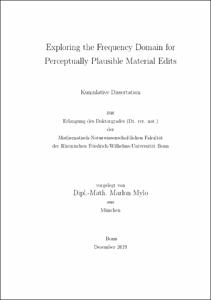Exploring the Frequency Domain for Perceptually Plausible Material Edits

Exploring the Frequency Domain for Perceptually Plausible Material Edits

| dc.contributor.advisor | Klein, Reinhard | |
| dc.contributor.author | Mylo, Marlon | |
| dc.date.accessioned | 2020-09-14T09:00:53Z | |
| dc.date.available | 2020-09-14T09:00:53Z | |
| dc.date.issued | 14.09.2020 | |
| dc.identifier.uri | https://hdl.handle.net/20.500.11811/8592 | |
| dc.description.abstract | The modeling of consistent 3D-Worlds and the rendering of photo-realistic images and films is a difficult task even for well-trained 3D-designers. This is in particular the case if the resulting media show material surfaces which do not or not yet exist. An established approach is to derive the reflectance-proper-ties and the mesostructure of an imaginary material surface from reflectance-properties and mesostructure of existing material surfaces. In other words this problem is approached by manipulating measured, digitalized material-surfaces. According to the importance of the problem, there have been published many computer graphical research papers in this field. As the rendering of photo-realistic images is essentially done by simulation of ray-optics, most publications concentrate on manipulating the physical properties of the measured materials. But those measured optical properties often do not allow to draw inferences about the underlying physical phenomena. That is why this approach often fails. In this thesis we are trying to find editing-systems which make use of the spatial contrast between those measured reflectance models. We want to reach this target by analysing and manipulating the spatial frequency-structure of the local reflectance-models. First we want to investigate how to make use of the Fourier-analysis to propagate a bichromatic stroke-input robustly over a material which bears at least one near-regularly textured channel. We will show that this near-regular-structure may be used to robustly generate high-quality editing masks to separate a foreground-pattern from the background. In the following we suggest perceptually motivated operations on the frequency spectrum. We will transfer a bandpass-filtering scheme, which has shown astonishing results in material-image editing, to bidirectional texture functions. To evaluate our approach we present many editing examples which show that this transfer of the original editing-scheme is reasonable and leads to good results. To motivate our next step we formulate the hypothesis, that this approach is in fact a manipulation of the perception. So we will evolve our approach by doing the frequency-analysis in an empirically founded computational cortex transform model instead of a Fourier- or a wavelet-analysis. Editing operations in this model are linear operations which have to be learned by the use of editing examples. We will show by exemplary comparisons that this model is not only capable of learning the mentioned editing-scheme but can also represent optical phenomena which then may be used as editing operation. | en |
| dc.language.iso | eng | |
| dc.rights | In Copyright | |
| dc.rights.uri | http://rightsstatements.org/vocab/InC/1.0/ | |
| dc.subject | BTF | |
| dc.subject | SVBRDF | |
| dc.subject | Material editieren | |
| dc.subject | Reflektanzerscheinungsraum | |
| dc.subject | Wandmustergruppenerkennung | |
| dc.subject | Material Editing | |
| dc.subject | Appearance Space | |
| dc.subject | Wallpapergroup Recognition | |
| dc.subject.ddc | 004 Informatik | |
| dc.title | Exploring the Frequency Domain for Perceptually Plausible Material Edits | |
| dc.type | Dissertation oder Habilitation | |
| dc.publisher.name | Universitäts- und Landesbibliothek Bonn | |
| dc.publisher.location | Bonn | |
| dc.rights.accessRights | openAccess | |
| dc.identifier.urn | https://nbn-resolving.org/urn:nbn:de:hbz:5-59608 | |
| ulbbn.pubtype | Erstveröffentlichung | |
| ulbbnediss.affiliation.name | Rheinische Friedrich-Wilhelms-Universität Bonn | |
| ulbbnediss.affiliation.location | Bonn | |
| ulbbnediss.thesis.level | Dissertation | |
| ulbbnediss.dissID | 5960 | |
| ulbbnediss.date.accepted | 08.07.2020 | |
| ulbbnediss.fakultaet | Mathematisch-Naturwissenschaftliche Fakultät | |
| dc.contributor.coReferee | Schilling, Andreas |
Dateien zu dieser Ressource
Das Dokument erscheint in:
-
E-Dissertationen (4337)




